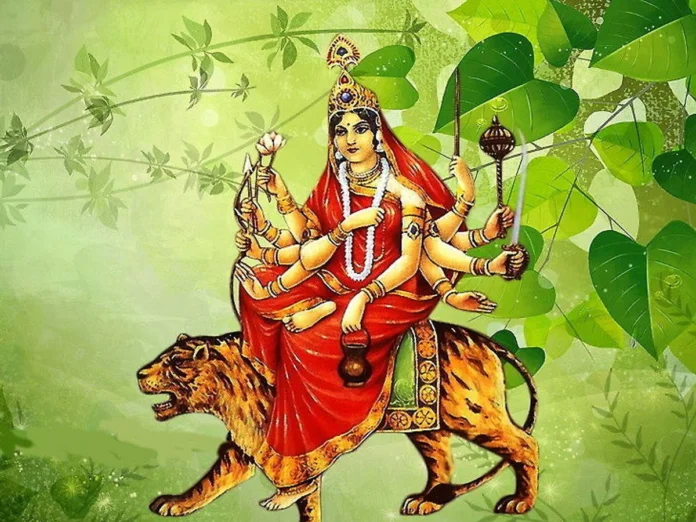
Navratri has commenced, filling the air with devotion and festive fervor. This nine-day festival is a tribute to Maa Durga in her various forms, and Day 3, known as Tritiya, is dedicated to Goddess Chandraghanta, representing beauty and courage. She emerges from a tigress and is often depicted with a crescent moon on her forehead resembling a bell. The color associated with her is red, symbolizing vitality, fervor, courage, and strength.
Navratri Day 3: Date
The third day of Shardiya Navratri falls on Tuesday, October 17, marking the Tritiya tithi of the Shukla Paksha, according to the Panchang.
Navratri Day 3: Puja Vidhi, Mantra, Shubh Muhurat
On Day 3, it is recommended that devotees wake up early, take a bath, and wear clean attire. Place the goddess’s idol in your puja room, cleanse it with Kesar, Ganga Jal, and Kewra. Adorn the goddess with yellow flowers, jasmine, panchamrit, and mishri. Check the auspicious muhurats for the day before starting any ritual:
- Brahma Muhurat: 4:42 AM to 5:33 AM.
- Abhijit Muhurat: Around 11:43 AM to 12:29 PM.
- Pratah Sandhya: 5:08 AM to 6:23 AM.
- Amrit Kalam: 11:23 AM to 1:02 PM
Navratri Day 3 Colour
The color associated with Goddess Chandraghanta is red. She is often depicted as a warrior goddess riding a tiger with ten arms and various weapons. Red symbolizes energy, vitality, and strength, inspiring individuals to take action and achieve their goals. Wearing red on Navratri Day 3 is believed to invoke the blessings of Goddess Chandraghanta, bringing good fortune and success.
Navratri Day 3 Mantras
- Om Devi Chandraghantayai Namah॥
- Pindaja Pravararudha Chandakopastrakairyuta। Prasadam Tanute Mahyam Chandraghanteti Vishruta॥
- Ya Devi Sarvabhuteshu Maa Chandraghanta Rupena Samsthita।Namastasyai Namastasyai Namastasyai Namo Namah॥
Navratri Day 3: Bhog
During Navratri, Bhog refers to the food offerings made to the Goddess and later distributed as prasad among devotees. The type of Bhog offered on Day 3 may vary from region to region, but it typically consists of vegetarian dishes, often prepared without onion and garlic, as it is considered pure and sattvic (pure and balanced). Common Bhog items on this day include:
- Kheer: A sweet rice pudding made with rice, milk, sugar, and flavored with cardamom and saffron.
- Puri: Fried bread made from wheat flour, usually served with a potato curry (aloo sabzi).
- Sabudana Khichdi: A dish made from soaked and cooked tapioca pearls, often seasoned with cumin and other spices.
- Paneer Dishes: Many people prepare dishes with paneer (cottage cheese) to offer as Bhog.
- Fruits: Even red fruits like pomegranates are offered.
Navratri Day 3: Significance
In Hinduism, Chandraghanta is the third form of goddess Mahadevi, worshipped on the third day of Navaratri. Her name, Chandra-Ghanta, means “one who has a half-moon shaped like a bell.” She signifies perpetual readiness for battle against evil, with her third eye always open. Chandraghanta is also known as Chandrakhanda, Vrikahvahini, or Chandrika, and she is believed to bless devotees with grace, bravery, and courage. Through her grace, devotees are relieved of sins, distress, physical and mental sufferings, and obstacles.
Legend
According to the Shiva Purana, Chandraghanta is the “Shakti” of Lord Shiva in the form of Chandrashekhara. Each aspect of Shiva is accompanied by Shakti, creating Ardhanarishvara, a balanced entity. The story tells of Chandraghanta’s battle against the demon Jatukasura, sent by the demon king Tarkasura to disrupt her peaceful life.
Goddess Chandraghanta is revered for her beauty, grace, and bravery. Her significance lies in her readiness to battle evil and bestow blessings on devotees. As Navratri continues, devotees across the world seek her divine grace and celebrate her power and benevolence.

